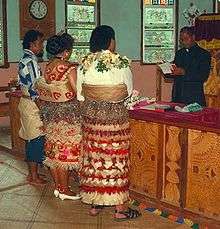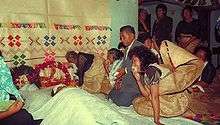Taʻovala
A taʻovala is an article of Tongan dress, a mat wrapped around the waist, worn by men and women, at all formal occasions, much like the tie for men in the European and North American culture. The ta'ovala is also commonly seen among the Fijian Lau Islands, a region once heavily influenced by Tongan hegemony and cultural diffusion.


Origins
According to a Tongan story, a group of Tongans once arrived by boat at the Tuʻi Tonga. They had had a rough ride and their clothing, if any remained, was not respectable. They cut the sail of their boat (Polynesian sails are also mats) in pieces and wrapped them around. The king was so pleased by the sacrifice they had made to him of their expensive sail that he ordered this dress to be court dress from then on. The Tongan waist-mat probably shares a common origin or inspiration as the Samoan "valatau" or "vala" waistband often donned by orators and chiefly sons ("manaia") and daughters ("taupou") on festive occasions and rituals.
Usage
Queen Salote Tupou III ordered the taʻovala to be part of the civil servants' uniform. The use of the taʻovala for men is therefore extremely common in Tonga. For women it is somewhat less common, as they prefer a kiekie.
The standard taʻovala, for formal and semi-formal wear, is a short mat coming halfway up the thighs. It is wrapped around the waist and tied with a kafa, a traditional rope often made of woven coconut coir or human hair belonging to a deceased ancestor. The mat worn on festive occasions, such as to one's own wedding, is much larger, finely woven and often very nicely decorated. This fine variant of ta'ovala is known as the ngafingafi, and corresponds to the 'Ie Tōga of the Samoans. The value of individual ngafingafi is determined by its colour, which may range from bleached white to a rich shade of tan or even coffee, depending on its age; the darker the colour, the greater the age, and the higher the value and prestige of the fine mat. Likewise the taʻovala for a funeral is also a huge mat, but much coarser and undecorated, woven from the rougher side of the pandanus leaf. If the wearer is of an inferior rank to the deceased, then the mat to be donned would be old, well-worn and tied in such a way as to wrap around the upper body and veil the head. The older and more torn it is, the better. All these special mats are kept as precious heirlooms.
Taʻovala are part of the koloa, the handicraft goods made by the women. Every woman can do it. If girls do not learn it at home, it will be taught at school. More recently, however, some women specialise in the handicraft and sell their products on the market.
Materials
Taʻovala can be made from different materials, natural and introduced:
- Strips of pandanus leaves, usually unpainted, although sometimes black strips are used, and rarely the whole taʻovala is black. The strips range from coarse (15 mm or so as for funerals) to fine (a couple of millimeters, as the taʻovala loukeha, in which one is dressed to visit the king). Mats are always woven by hand. Especially the fine mats are therefore very laborious to make, take a long time to complete and are expensive. The oldest and most valuable Tongan fine mats are preserved and worn by the Tongan royal family on formal occasions.
- Strips of hibiscus bast fiber, called fau. Same as the pandanus leaves, but not as coarse and as such they can be plaited in a variety of patterns, which is faster and cheaper than to weave them by hand. Most of the 'civil servants' taʻovala are made in this way.
- Plastic, particularly those obtained from old flour bags - preferred as a quick alternative.
History
Before the advent of Western influence, the men wore a fringe skirt of native materials about 25 to 30 inches (60 to 80 cm) long. Women traditionally[1] wore two mats about a yard (metre) square each, made by weaving pandanus and hibiscus leaves together,[2] and belted around the waist.[3] Children were usually naked.[2][4] The Christian missionaries who began arriving in the late 19th century influenced the islanders' notions of modesty.
See also
References
- Briand, Greta; Peters, Ruth (2010). "Community Perspectives on Cultural Considerations for Breast and Cervical Cancer Education among Marshallese Women in Orange County, California" (PDF). Californian Journal of Health Promotion (8): 84–89. Retrieved 25 August 2013.
- "Introduction to Marshallese Culture". Retrieved 17 August 2013.
- Bliss, Edwin Munsell (1891). The Encyclopedia of Missions. II. New York: Funk & Wagnalls.
- "Marshallese Culture". Retrieved 16 August 2013.
- ʻI.F. Helu; Critical essays: Cultural perspectives from the Southseas; 1999